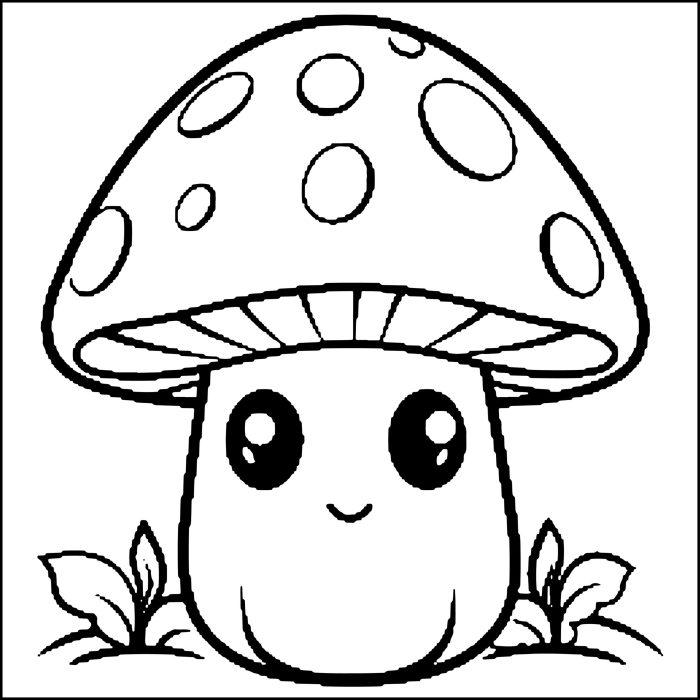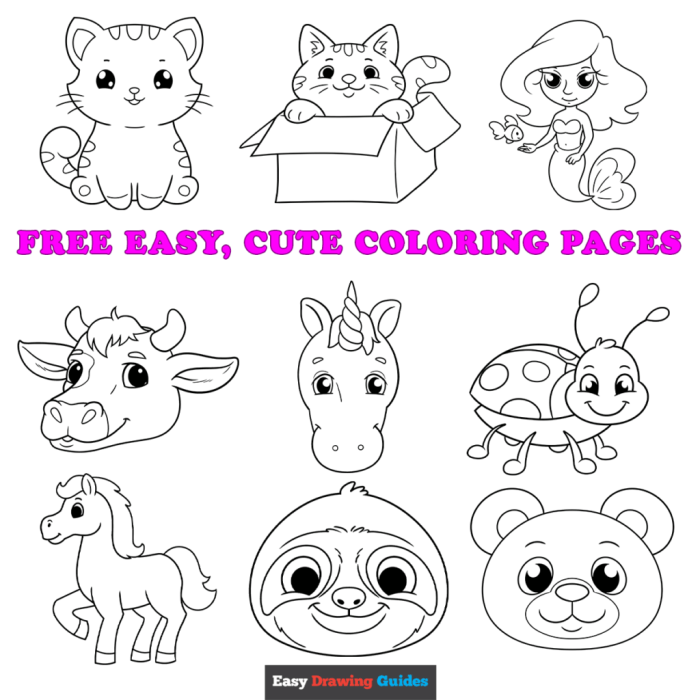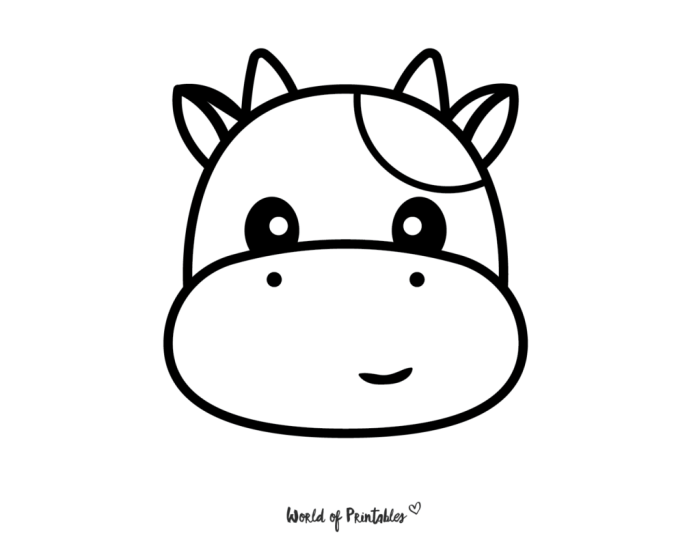Target Audience Identification: Cute And Easy Coloring Pages
Determining the ideal audience for cute and easy coloring pages is crucial for maximizing engagement and ensuring the content’s effectiveness. Understanding the age range, interests, and preferences of the target demographic allows for the creation of coloring pages that are both appealing and developmentally appropriate.The primary target audience for cute and easy coloring pages is young children, generally ranging from ages 2 to 6 years old.
This age group is characterized by a developing fine motor skill set, a burgeoning imagination, and a strong preference for bright, visually stimulating imagery. Their interests frequently revolve around familiar characters, animals, and simple, recognizable objects. At this age, coloring acts as a valuable tool for enhancing hand-eye coordination, promoting creativity, and fostering self-expression.
Age Range and Characteristics
Children aged 2-6 are still developing their fine motor skills, making simple designs with large, clearly defined areas ideal. They often possess short attention spans, so the coloring pages should not be overly complex or detailed. The imagery should be recognizable and relatable, often featuring familiar animals like cats, dogs, and bears, or common objects such as flowers, fruits, and vehicles.
Simple, repetitive patterns are also well-received. The focus is on the act of coloring itself, rather than intricate detail. For example, a large, friendly-looking puppy with clearly defined sections for coloring would be more appealing than a detailed portrait of a realistic dog.
Preferred Color Palettes and Themes
Bright, bold colors are generally preferred by this age group. Primary colors (red, yellow, blue) and their combinations are highly engaging. Pastel shades can also be appealing, but should not be overly muted. The themes should be cheerful and positive, avoiding anything that might be frightening or upsetting. Popular themes include:
- Animals (cute and cartoonish versions)
- Simple objects (fruits, vegetables, toys)
- Familiar characters (from popular children’s books or cartoons, but avoiding licensed characters to avoid copyright issues)
- Nature scenes (flowers, trees, rainbows)
- Transportation (cars, trains, airplanes – simplified designs)
For example, a coloring page featuring a bright yellow sun with smiling faces for each ray, surrounded by simple, brightly colored flowers, would be highly engaging for this target demographic. Alternatively, a page depicting a cartoonish cat playing with a ball of yarn in vibrant pinks, blues, and greens would also be well-received. The key is simplicity, bright colors, and positive imagery.
Cute and easy coloring pages are a fantastic way to unwind and unleash creativity. If you’re looking for something slightly more whimsical, consider exploring coloring pages of doodles ; they offer a delightful blend of simple shapes and charming designs. Returning to the simplicity of cute and easy coloring pages, remember that the best designs are those that bring you joy and relaxation.
Design Elements of Popular Coloring Pages

Creating successful “cute and easy” coloring pages hinges on understanding the visual appeal that resonates with the target audience. Simple yet engaging designs are key, ensuring both ease of coloring and a satisfying final product. The following elements contribute significantly to the popularity of these pages.
Several key design elements contribute to the success of cute and easy coloring pages. These elements work together to create visually appealing and engaging designs that are enjoyable for children to color.
Popular Design Elements in Cute and Easy Coloring Pages
The following list details five popular design elements frequently found in successful cute and easy coloring pages, along with explanations of their appeal:
- Large, Simple Shapes: Large, easily identifiable shapes like circles, squares, and hearts form the basis of many designs. Their simplicity makes them accessible to young children with limited fine motor skills, promoting a sense of accomplishment.
- Bold Artikels: Thick, clearly defined Artikels provide a strong visual guide, making it easy for children to stay within the lines. This reduces frustration and enhances the coloring experience.
- Cute and Familiar Characters: Animals, cartoon characters, and other familiar imagery are highly appealing. These elements tap into children’s existing interests and provide a relatable context for coloring.
- Repetitive Patterns: Simple, repetitive patterns (like stripes, polka dots, or zigzags) offer opportunities for practicing fine motor skills and color blending. The predictability of these patterns can also be calming and enjoyable.
- Positive and Bright Colors: Vibrant and cheerful colors evoke positive emotions and enhance the overall visual appeal. This makes the coloring process more engaging and fun.
Example Coloring Page Thumbnails
The following descriptions illustrate three example coloring page thumbnails, showcasing varying levels of complexity while incorporating the design elements discussed above:
Thumbnail 1: Simple Flower This thumbnail features a large, single flower with oversized petals. The petals are defined by bold Artikels and are filled with simple, repetitive patterns of dots and stripes. The flower is colored with bright, cheerful yellows, pinks, and oranges. This design is ideal for very young children.
Thumbnail 2: Cute Kitten This thumbnail depicts a simplified kitten sitting. The kitten has large, simple shapes for its body and head, with bold Artikels. The design includes simple repetitive patterns on its tail and incorporates a playful expression. The color palette is soft and pastel, using light pinks, blues, and creams.
Thumbnail 3: Detailed Castle This thumbnail shows a slightly more complex design of a small castle with multiple towers and windows. While the basic shapes are still simple, the level of detail is increased by adding small features like flags and decorative elements. Bold Artikels are still used, but the patterns are more varied and intricate. The color palette is a mix of brighter, more saturated colors, such as reds, blues, and greens, allowing for more creative color choices.
Design Element Comparison: Younger vs. Older Children
While the core design elements remain consistent, subtle differences exist in coloring pages targeted at younger versus older children within the “cute and easy” category.
Coloring pages for younger children (preschool age) typically feature extremely simplified shapes, very bold Artikels, and large areas for coloring. Repetitive patterns are often prominent, and the color palettes are generally limited to bright, primary colors. The focus is on developing fine motor skills and fostering a positive coloring experience. In contrast, coloring pages for older children (early elementary age) may include slightly more intricate designs with smaller details and more varied patterns.
While still “cute and easy,” these pages offer more opportunities for creativity and color exploration, using a wider range of colors and potentially incorporating subtle shading or gradients.
Content Creation & Themes
Creating engaging and appealing themes is crucial for the success of cute and easy coloring pages. The themes should resonate with the target audience, offering a balance of simplicity and visual interest to encourage coloring and creative expression. The following themes aim to achieve this balance, catering to a broad age range with diverse interests.
Theme Ideas for Cute and Easy Coloring Pages
The selection of themes should consider factors such as current trends, child development stages, and overall aesthetic appeal. A diverse range of themes ensures broader market appeal and caters to varied interests. The following table details five unique theme ideas, along with their specific elements and suggested color palettes.
| Theme Name | Target Age | Key Elements | Color Palette Suggestions |
|---|---|---|---|
| Adorable Animals | 3-6 years | Simple depictions of popular animals like cats, dogs, bunnies, and pandas. Large, easily colorable shapes. Simple backgrounds, perhaps a grassy field or a colorful balloon. Consider adding simple accessories like bows or hats. | Pastel shades (pink, light blue, yellow), bright primary colors (red, blue, yellow), earth tones (browns, greens). |
| Magical Unicorns & Rainbows | 4-8 years | Unicorns with flowing manes and tails, rainbows with distinct color bands, stars, clouds, and simple floral elements. Backgrounds could include a whimsical sky or a rainbow-colored meadow. | Bright, vibrant colors, including pastel shades for a softer look, metallic accents for the unicorn horn. |
| Sweet Treats & Desserts | 5-9 years | Cute illustrations of ice cream cones, cupcakes, cookies, and candies. Simple shapes and details to make coloring easy. Backgrounds could include a bakery setting or a picnic scene. | Pastels and bright, candy-like colors. Consider using gradients to add depth and interest. |
| Under the Sea Adventures | 6-10 years | Friendly sea creatures like fish, sea turtles, starfish, and crabs. Simple coral reefs or ocean backgrounds. Consider adding bubbles or seaweed. | Blues, greens, and teals, with pops of brighter colors for the sea creatures. |
| Outer Space Explorers | 7-12 years | Friendly aliens, rockets, planets, stars, and constellations. Simple designs and shapes. Backgrounds could include a starry night sky or a colorful planet. | Darker blues and purples for the night sky, bright colors for planets and aliens, metallic accents for the rockets. |
Simplicity and Ease of Use

Creating truly enjoyable coloring pages hinges on their simplicity and ease of use, particularly for young children. A coloring page that is too complex or intricate can be frustrating and discouraging, leading to a negative experience. Therefore, thoughtful design choices are crucial to ensure accessibility and enjoyment.Ease of coloring is primarily determined by the line art’s simplicity and the size of the shapes.
Children with developing fine motor skills need larger areas to color and fewer intricate details to navigate. The absence of overly small spaces or thin lines minimizes frustration and allows children to focus on the creative process rather than the technical challenges of coloring.
Design Techniques for Simplified Coloring Pages
Simple design techniques are key to creating accessible and enjoyable coloring pages for young children. These techniques focus on creating larger, more manageable shapes and reducing the overall level of detail.
- Large Shapes: Instead of small, numerous shapes, utilize fewer, larger shapes. Think bold Artikels of animals, simple flowers with wide petals, or large, easily filled-in geometric forms. This provides a less overwhelming experience and allows for quick, satisfying results.
- Limited Detail: Avoid intricate patterns or small, fiddly details within the shapes. Focus on clean, simple lines and shapes. For example, a simple Artikel of a cat is preferable to a cat with detailed fur textures.
- Bold Artikels: Thick, clearly defined Artikels are crucial for younger children. These thicker lines make it easier for them to stay within the boundaries while coloring and reduce the chance of accidental coloring outside the intended area. Thin lines can be challenging to follow, leading to frustration.
- Open Spaces: Incorporate ample white space within the design. This helps to prevent the coloring page from feeling cluttered and overwhelming. White space also allows the colors to breathe and enhances the overall visual appeal.
Creating a Simple Line Art Design
The following steps demonstrate how to create a simple line art design suitable for a coloring page. This example focuses on a friendly-looking sun.
- Step 1: Basic Shape: Begin by drawing a large circle. This will form the main body of the sun.
- Step 2: Rays: Add triangular rays extending outwards from the circle. Keep the rays relatively large and evenly spaced. Avoid overly complex ray shapes or adding too many rays.
- Step 3: Face (Optional): For added cuteness, you can add a simple smiling face to the sun. Use two small circles for eyes and a curved line for the mouth. Keep the features large and easy to color.
- Step 4: Refinement: Review your drawing. Ensure that all lines are thick enough and that the overall design is simple and uncluttered. Adjust any lines or shapes as needed to improve clarity and ease of coloring.
Cuteness Factor Analysis

The inherent appeal of “cute” coloring pages hinges on a specific combination of visual elements that trigger positive emotional responses in the viewer, particularly children. Understanding these elements is crucial for designing coloring pages that are not only engaging but also highly desirable. This analysis will explore the key visual cues that contribute to the overall “cuteness” of a design, and how these can be effectively implemented.The creation of a charming and appealing coloring page relies on a delicate balance of visual cues.
These cues often tap into inherent human preferences for certain shapes, colors, and expressions, triggering a feeling of warmth and affection. By strategically combining these elements, designers can create coloring pages that resonate deeply with their target audience and evoke a strong desire to color them. The following discussion will delve into the specific elements that contribute to this effect.
Visual Cues for Enhanced Cuteness, Cute and easy coloring pages
The perception of “cuteness” in character design is significantly influenced by several visual cues. These cues, when used effectively, can transform an ordinary drawing into a charming and endearing character. These cues are not arbitrary; they often reflect innate human responses to certain visual patterns.
- Large, expressive eyes: Large eyes, often disproportionately large compared to the rest of the face, are a classic hallmark of cute characters. These eyes convey innocence, vulnerability, and emotional expressiveness, instantly making the character more appealing.
- Soft, rounded features: Sharp angles and harsh lines tend to create a more serious or even intimidating appearance. In contrast, soft, rounded features like cheeks, noses, and chins create a gentle and approachable look, enhancing the perception of cuteness.
- Pastel color palettes: Bright, saturated colors can be overwhelming. Pastel colors, with their muted tones and soft hues, create a calm and soothing atmosphere, contributing to the overall feeling of gentleness and sweetness associated with cuteness.
- Small mouths and noses: Similar to large eyes, smaller mouths and noses contribute to a childlike and innocent appearance. These features often reduce the perceived maturity of the character, emphasizing its vulnerability and sweetness.
- Fluffy or plush-like textures (implied): While coloring pages are inherently two-dimensional, visual cues can be used to imply texture. For example, using short, rounded lines to depict fur or soft fabric can suggest a plush-like quality, enhancing the feeling of softness and cuddlieness.
Marketing and Distribution
Successfully distributing cute and easy coloring pages requires a multi-pronged approach leveraging both online and offline channels. Understanding the target audience’s preferences and online habits is crucial for effective marketing and maximizing reach. This section details potential platforms and promotional strategies.Effective marketing hinges on identifying the right platforms and employing suitable promotional strategies to reach the target audience efficiently.
Choosing the correct channels will depend on factors like budget, target demographic, and desired reach. A combination of strategies is usually most effective.
Distribution Platforms
Several platforms offer viable avenues for distributing cute and easy coloring pages. Each platform has unique advantages and disadvantages, influencing the overall marketing strategy.
- Websites: Creating a dedicated website allows for direct sales of digital coloring pages or printable downloads. This provides complete control over branding and offers the opportunity to build an email list for future promotions. However, website creation and maintenance require time and resources.
- Apps: Developing a dedicated coloring app offers an interactive experience, potentially including features like color palettes and in-app purchases. This approach necessitates significant development costs and technical expertise. However, apps can offer a more engaging experience and potentially generate higher revenue through in-app purchases.
- Social Media: Platforms like Instagram, Pinterest, and Facebook offer organic reach and paid advertising options. Visual platforms like Pinterest are particularly suitable for showcasing coloring pages. Social media requires consistent engagement and content creation to maintain visibility.
- Online Marketplaces: Etsy, Amazon, and similar platforms provide access to a large customer base. However, these platforms often involve fees and competition from other sellers.
Promotional Methods
Promoting the coloring pages requires a well-defined strategy utilizing various methods to increase visibility and generate sales.
- Social Media Marketing: Engaging content, including visually appealing posts and reels, coupled with targeted advertising, can effectively reach the target audience. Running contests and giveaways can further boost engagement and brand awareness.
- Email Marketing: Building an email list allows for direct communication with potential customers, offering exclusive deals and promotions. Email marketing is cost-effective and allows for personalized messaging.
- Influencer Marketing: Collaborating with relevant influencers, such as parenting bloggers or craft enthusiasts, can significantly expand reach and build credibility. This strategy often involves providing free coloring pages or offering a commission on sales.
- Paid Advertising: Utilizing platforms like Google Ads and social media advertising allows for targeted campaigns based on demographics and interests. Paid advertising can be expensive, but it can generate significant traffic and sales.
Printable versus Digital Coloring Pages
Offering both printable and digital versions caters to diverse preferences and needs, maximizing potential sales.
- Printable Coloring Pages: Offer convenience and immediate gratification. They are easily accessible and can be printed at home, but they may require additional shipping costs if sold physically. They also lack the interactive features of digital versions.
- Digital Coloring Pages: Offer flexibility and convenience. They are instantly accessible and can be printed multiple times, eliminating the need for shipping. They also can be easily updated and distributed, but may require specialized software for use and could potentially be shared easily without compensation.
